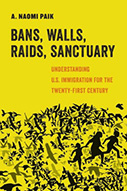Bans, Walls, Raids, Sanctuary: Understanding U.S. Immigration For The Twenty-First Century

Author: A. Naomi Paik
Publisher: Oakland, CA: University of California Press, 2020. 173p.
Reviewer: Nicolás Eilbaum | February 2021
A. Naomi Paik’s Bans, Walls, Raids, Sanctuary argues that despite the horror of Donald Trump’s anti-immigrant rhetoric, his policies were not new. Indeed, Trump’s approach was more aligned with historical and current U.S. immigration policy than his rhetoric let on. Paik organizes the argument around three executive orders that Trump issued early in his presidency: The first banned the entry into the country of people from seven Muslim-majority countries; the second mandated the “immediate construction of a physical wall” on the Southern border (a centerpiece of Trump’s 2016 campaign); and the third to unleash Immigration and Customs Enforcement’s deportation powers. Like other policies that followed—from DACA rescission to family separation—these three initial orders disrupted lives and terrorized families, but they did not necessarily reshape immigration policy.
The book’s argument is clear: Only “historical amnesia” would let us “mistake the Trump administration for a novelty” (p. 3). Trump’s immigration policies have deep roots in America’s past: the ban goes back to previous bans; the wall goes back to previous walls (or the same wall); the raids go back to countless previous raids. On the one hand, the author connects Trump’s policies to the country’s very foundation, one in which the government included some and excluded others, and which remains central to our system. On the other hand, the last 40 years (the era of “neoliberalism”) serve as the immediate precondition for the present. Trump’s anti-immigrant policy and rhetoric, Paik argues, draws heavily on the scapegoating and criminalization of the poor that became part and parcel of economic inequality and social dislocation in the 1980s. Whether traced back to the nation’s beginnings or only the last four decades, harsh immigration policy has been long in the making and will not go away. “The problem is not Donald Trump,” the author states flatly. “The problem is the United States of America” (p. 131).
There are, however, breaks between Trump’s approach and the past that the book seems to downplay. The author writes that the 1965 Immigrant Act “roughly marks the neoliberal turn in immigration issues” (p. 14) wherein the law replaced racially explicit discrimination by country of origin (quotas) with the (“neoliberal”) principle of “formal equality.” Though framed as racially neutral, Paik shows that the new system was anything but, implicitly creating larger obstacles for some migrant groups than for others. Yet one could also argue that the principle of no discrimination, even when far from effective, at least offered a standard to which the law’s outcomes could be compared. Trump’s approach to immigration, in contrast, has rejected “formal equality” or any other principle. Immigration policy is now guided by self-interest alone.
The distinction between Trump’s approach and the post-1965 immigration system can be made more broadly. If U.S. immigration policy was “fair” in theory and “unfair” in practice, now it’s unfair both in theory and practice. If the immigration system was both coldly administrative and brutally destructive, now it’s all about open—almost festive—destruction. If the system drew deceptive lines between “good” and “bad” immigrants, now it sees only criminals and terrorists. If the system pretended to be racially and religiously neutral, now it’s “us versus them.” If “neoliberalism” and “globalization” carried an implicit rhetorical tension between free trade and closed borders, now there’s no tension because everything is closed. U.S. immigration policy was long rife with contradictions. Now, Trump has done away with the contradictions.
The book’s last chapter discusses “sanctuary” as a response to Trump’s attack on immigrants. Paik distinguishes between sanctuary jurisdictions (such as “sanctuary cities”) and community- or church-based sanctuary. Government-sponsored sanctuary involves state and local governments limiting cooperation with federal immigration enforcement. In contrast, community or church-based sanctuary, the “millennia-old practice of offering refuge” embodies a very different approach, historically offering “a fundamentally separate—and ultimate—source of authority, grounded in the divine,” and thus contesting “the sovereign power integral to the nation-state” (p.105). That is why “liberal democracy and sanctuary are antagonistic to each other” (p. 111). If government sanctuary reflects clashing immigration policies, community sanctuary rejects immigration policy entirely.
This is the movement-in-progress, which the author calls “abolitionist sanctuary,” connecting “sanctuary’s radical welcome, its judgment-free embrace of anyone, to abolition, defined as social justice organizing that seeks to tear down oppressive power structures” like immigration enforcement (p. 113). This point echoes recent calls for abolishing ICE, but Paik doesn’t frame abolition as a matter of immigration policy. To abolish ICE (and abolitionism more broadly) is a vision for what all of us—coming together as a community of migrant and non-migrants—can envision and fight to achieve. It’s not about government policy. It’s about seeing and building human connections that would make it unthinkable to draw militarized lines around us.
This book imagines a “deep and complete re-envisioning of society” (p. 118). One question is what this vision—based on relationship-building and a “commitment to taking care of each other” (p. 113)—means for migrants whose community ties may be somewhere else. What matters, Paik writes, is that “you are here with us, which means that I am accountable to you, and you are accountable to me” (p 141-2). But not all migrants are here, or not fully here: their minds and hearts are also somewhere else. What does it mean to be accountable to each other when we are on the move? How do we reconcile the uprooting and transience of migration with the roots and bonding of community? Migration is about freedom, this thought-inspiring book tells us, but freedom depends on human ties.
Nicolás Eilbaum, Greensboro College


